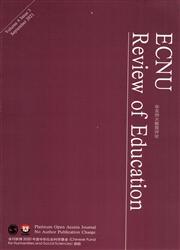通过合作推理促进中国学生的创造性表现
IF 2.7
Q1 EDUCATION & EDUCATIONAL RESEARCH
引用次数: 0
摘要
创造力受到现代社会的高度重视;然而,在中国,创建以学校为基础的课程或促进学生创造力的课程是一个重大挑战。本研究引入了一种称为协作推理(CR)的交互式学习形式。目的是调查CR是否会提高学生产生创造性想法的能力。该数据包括中国北方一所农村中学八个班的474名七年级学生。八个班被随机分配到两个条件下:四个班参加CR讨论,其余四个班通过教师指导的语文阅读课进行教学。在参与CR讨论后,学生们完成了一项现实问题测试,旨在评估他们的创造性表现。结果表明,与对照组学生相比,CR学生对三个现实问题产生了更有效的解决方案(流利性),并提出了更多样的解决方案。CR学生提出的解决方案比对照组提出的更独特(新颖),在现实生活中更有用(有用)。在社会环境中提供丰富的思想交流机会可以提高学生创造性解决问题的能力。本文章由计算机程序翻译,如有差异,请以英文原文为准。
Promoting Chinese Students’ Creative Performance Through Collaborative Reasoning
Creativity is highly valued by modern society; however, in China, there is a major challenge in creating school-based curricula or courses that promote students’ creativity. This study introduced an interactive learning format called Collaborative Reasoning (CR). The goal was to investigate whether CR would improve a student's ability to generate creative ideas. The data comprised 474 seventh graders from eight classes in a rural middle school in northern China. The eight classes were randomly assigned to two conditions: Four classes participated in CR discussions, and the remaining four classes were taught via teacher-directed Chinese reading classes. After participating in the CR discussions, students completed a Realistic Presented Problem test that was designed to evaluate their creative performance. The results indicated that compared to the control students, CR students generated more effective solutions (fluency) and proposed a greater variety of solutions (flexibility) to three realistic problems. The solutions proposed by the CR students were more unique (novelty) and more useful in real-life situations (usefulness) than those proposed by the control group. Providing abundant opportunities for the exchange of ideas in a social context can boost students’ performance in creative problem-solving.
求助全文
通过发布文献求助,成功后即可免费获取论文全文。
去求助
来源期刊

ECNU Review of Education
Social Sciences-Education
CiteScore
4.90
自引率
0.00%
发文量
41
审稿时长
10 weeks
 求助内容:
求助内容: 应助结果提醒方式:
应助结果提醒方式:


